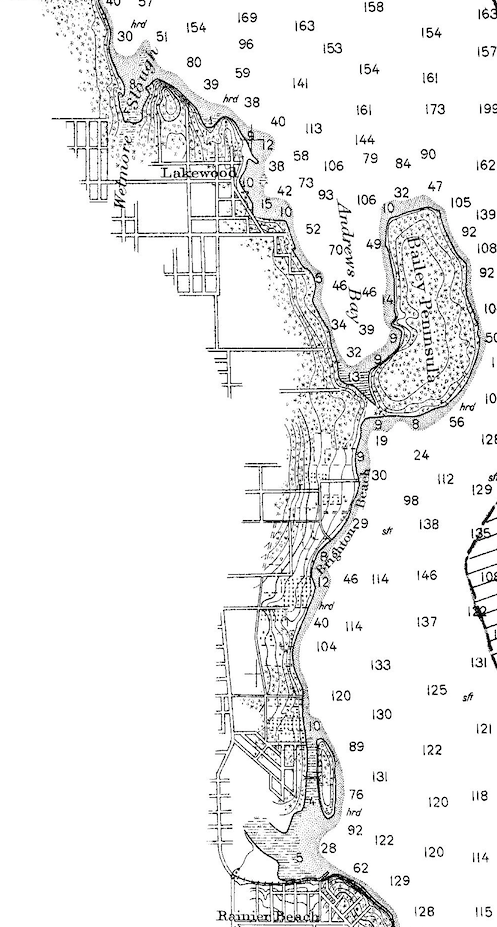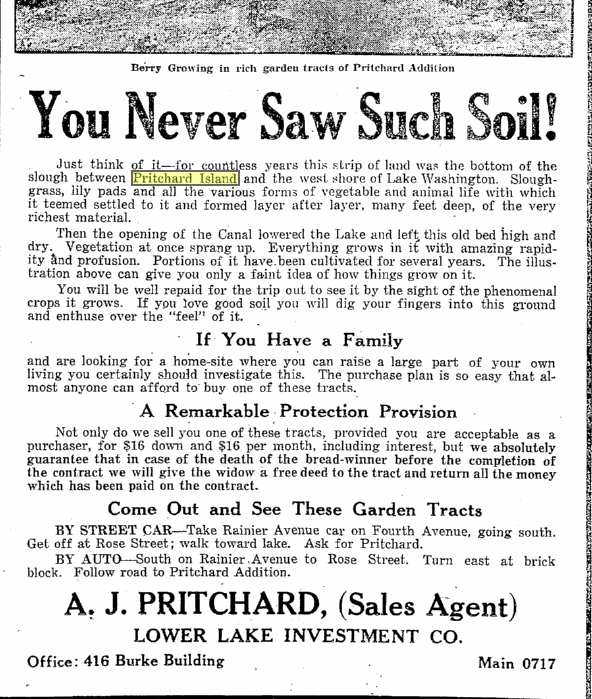Augustus Koch arrived in Seattle in the summer of 1890. Like many his age, 49 years old, he had fought in the Civil War, where he had been draughtsman making maps. He had come to Seattle to do the same but it would not be a typical map. For the past two decades Koch had traveled the country producing fantastic aerial views of cities from Jacksonville, Florida, to Los Angeles. One newspaper reporter gushed that Koch’s maps depicted “every street, block, railroad track, switch and turn-table, every bridge, tree, and barn, in fact every object that would strike the eye of a man up a little ways in a balloon.”
[nggallery id=37]Koch achieved the same exquisite detail in Seattle, except that his imaginary viewer would have been very high up in a balloon, looking down at Seattle from a perspective over what is now Pigeon Point in West Seattle. Measuring 32 by 50 inches and published as a limited edition lithograph in January 1891, the map took six months to complete. (I have not been able to track down what it cost, how many were printed, who sold it, and how many survive.) Koch’s map combines an engineer’s quest for details and an artist’s imagination to make those details come to life.
Plying the waters of Elliott Bay are more than a dozen schooners, colliers, barks, tugs, sternwheelers, and paddle wheelers, as well as another dozen double- and triple-masted ships and paddle wheelers. Koch has named three of the larger vessels, the steamships Willamette and Walla Walla, and the U.S. Man of War Charleston, each more than 300 feet long. Long used for transporting coal from Seattle, the Walla Walla had recently been fitted as a passenger ship running between San Francisco and Puget Sound. Also making the same run was the Willamette, which in 1890 carried more than 49,000 tons of coal to California.
Koch’s smaller vessels were part of the legendary Mosquito Fleet. Generally powered by steam and with flat bottoms, which allowed access to shallow ports and travel up river, the fleet ferried everything from eggs to mail to people to lumber. They were the short haul truckers of the day, keeping far flung communities throughout Puget Sound supplied with goods from the main port in Seattle.
What stands out most is the phenomenal presence of rail. Fifteen trains, the longest of which pulls 16 cars, travel on tracks to, through, and from Seattle. More waiting boxcars rest on the tracks and thirteen trolleys carry passengers across the city. The tracks of the trains so dominate the waterfront that you cannot reach any part of Elliott Bay from Beacon Hill to Smith Cove without crossing at least one and up to five tracks.
Supplementing the several miles of train trestles on the tidal flats is an extensive wharf system. They give the city’s south end an appearance of trying to become a new Venice, floating atop the water. These were working wharves with a ship building facility, several lumber mills with vast piles of logs, immense coal bunkers, railroad depots, boiler works, a hotel, a laundry, and a foundrys. More piers extend west over the tidal flats from the base of Beacon Hill, including one shingle mill with a vast pile of sawdust in front of it, reminiscent of sandy island in a tidal lagoon.
I have no reason to doubt the basic veracity of Koch’s drawings. In other parts of the country where Koch worked, modern researchers have compared his bird’s eye views with photographs and maps and found him to be remarkably accurate. I have though talked to a maritime historian who told me that all of those ships couldn’t have been in the harbor on the same day (they would needed too much space to turn around), but his portrait accurately reflects what a typical Seattleite would have seen in their growing city.
[UW Architecture professor Jeffrey Ochsner pointed out in a follow up email to me that Koch’s map is not perfect. “Those who drew these images wanted to keep them up-to-date, so they put in buildings that were expected to be built. In some cases those buildings were not built. The 1891 panoramic lithograph of Seattle shows the Seattle Opera House by Adler & Sullivan that never went beyond the foundation (and, as I recall, it also shows the Equitable Building by John Parkinson, a building that never went forward). There may be other buildings that were not built but these two are the ones I know of.”]
In the 18 months since the Great Fire of 1889 had burned downtown to the ground, everyone had rushed to rebuild, usually bigger and certainly more substantial with brick and stone instead of wood. The sounds of hammers, saws, chisels, sledges, and pile-drivers resounded with the Seattle Spirit. Ships arrived daily bringing in goods and supplies and taking out raw materials. Seattleites would have to wait two more years for direct transcontinental rail service, but trains arrived and departed daily from points south and east. It must have been an exciting time to live here.
Although the map represents Koch’s vision of Seattle, and not a true-to-life photographic picture, it does provide a remarkable snapshot of a city on the cusp of change from its pioneer roots to its status as the most important city in the state.
Material for for this story comes out of research I have done for my new book on Seattle – Too High and Too Steep: Reshaping Seattle’s Topography.
If you so desire, you can like my geologywriter Facebook page.

